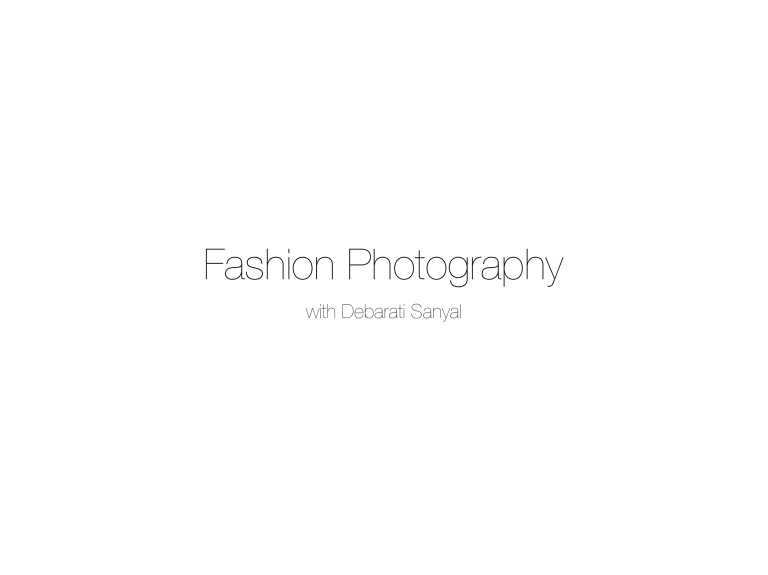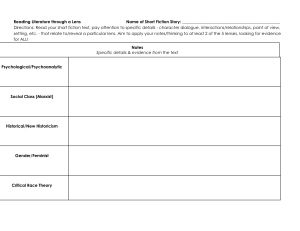
Fashion Photography with Debarati Sanyal What is Fashion Photography? It’s an essential amalgamation of two genres. Fashion and photography. Aspects enhancing fashion photography - model, hair & makeup, light (natural + artificial), set, post production. Types of Fashion Photography Editorial Photography Set of images used to convey a concept. Not shot from a advertising perspective. Usually seen in magazines & test shoots. Commercial Photography Used for marketing & advertising brands. Solely used for selling products. Brand shoots, perfume campaigns etc. What do we need to make a fashion photograph? Camera Model Location Lights Stylist Hair & Makeup Post Production Clothes! Camera Digital Camera - DSLR, Mirrorless, Compact Film Camera - SLR, TLR, Rangefinder, Point & Shoot, Pinhole Camera. https://projekarka.wordpress.com/camera-types/ The DSLR Digital Single Lens reflex. Sharp and spectacular images Advanced sensors, manual settings, and a wide range of interchangeable lenses A DSLR consists of a body—the part of the camera that records the image—and a removable lens. This ability to change lenses on a DSLR gives you lots of flexibility. DSLRs are designed to let you see the image exactly as the camera itself will record. The photos are high quality and will reproduce well when printed DSLRs tend to be very responsive—there is no lag time between when you snap your picture and when the image is recorded, so you'll never miss a moment. There are tons of lenses available for most brands of DSLR cameras which gives you lots of creative options. All DSLRs will give you full control, and most give you some pre-programmed automatic or semi-automatic modes. Some DSLR models also have video capability, allowing you to capture beautiful high-definition movies. What is a megapixel? Digital cameras capture images as pixel elements, known as pixels. Simply put, a megapixel is equal to one million pixels. Digital images are made up of thousands of these tiny, tile-like picture elements. The more pixels, the higher the image resolution. Resolution relates primarily to print size and the amount of detail an image has when viewed on a computer monitor at 100%. What is depth of field? Depth of field is the distance between the closest and farthest objects in a photo that appears acceptably sharp. A camera can only focus sharply at one point. But the transition from sharp to unsharp is gradual, and the term ‘acceptably sharp’ is a loose one! How you will be viewing the image, and at what size you will be looking at it are factors which contribute to how acceptably sharp an image is. https://petapixel.com/2016/05/18/depth-field-explained/ What is Aperture? Aperture is the opening in your lens that lets light pass through to the sensor. Think of it as a pupil for your lens. It dilates to let more light in, and contracts to restrict light when it is bright. Aperture is probably the first thing most photographers think of when they want to adjust the depth of field. What is focal length? The focal length of the lens is the distance between the lens and the image sensor when the subject is in focus, usually stated in millimeters (e.g., 28 mm, 50 mm, or 100 mm). In the case of zoom lenses, both the minimum and maximum focal lengths are stated, for example 18–55 mm. Types of lens The focal length of the lens is the distance between the lens and the image sensor when the subject is in focus, usually stated in millimeters (e.g., 28 mm, 50 mm, or 100 mm). In the case of zoom lenses, both the minimum and maximum focal lengths are stated, for example 18–55 mm. Prime Lens - fixed focal length, e.g. - 50mm, 85mm, 35mm, portraits, close-ups with shallow depth of field and good bokeh effect, simple design allows for refined visuals and higher quality images. Wide Angle lens - small focal lengths (18-30mm), useful when you are trying to capture broader area. Perfect for Landscape shots, perfectly fit in the wide-lens frame where you try shooting scenic beauty, interiors and pull more of the subject in the photograph, low angle shots can experience distortion. Telephoto lens - Telephoto lens removes the barricade of physically getting closer to a subject to capture it. These lenses are ideal for wildlife photography, also known as zoom lens, 100mm, 70-200mm Macro lens - Perfect to shoot small objects from up close. These lenses magnify small subject and offer close focusing distance. Lenses with a focal length between 90mm to 105mm are best suited to shoot extreme closeup shots. These lenses have ‘convenient minimum focus distance’ and adds a natural effect to the image. Fish-eye lens - Fish-eye is the ultra wide-angle lens that is useful when you are trying to fit in almost everything possible in the frame. Popular in the area of artistic photography, extreme sport, wide panorama, architecture, big crowds etc. These lenses, however, suffer from barrel distortion (curved edges) making the subject at the centre look bulged out. Produces high distortion. The fish-eye lens can capture shots with a field view of 180 degrees and 360 degree. https://www.nikonusa.com/en/learn-and-explore/a/tips-and-techniques/understanding-focal-length.html Types of lights Studio Lights Studio equipment generally falls into one of two categories: strobe and continuous lighting. Additionally setting source of continuous light (pilot light) on a strobe device. Pilot lamp is used to illuminate the subject, improve focusing, pre-assessment of light casting and shadows. Characteristics of the strobe lights Lighting devices have a number of characteristics that should be taken into account organising the shooting process. I’ll outline some of them: - Color temperature (measured in degrees by Kelvin system), typically ranges from 5500–5600 ? K. Color temperature is directly connected to a term White Balance (WB). You should choose one of the modes for white balance setting up your camera. flash using white sheet daylight 5600 ? K - Strobe energy Usually measured in Joules (J). In small photo studios it is usually varies between 100 and 1000 Joules. You can find out the exact number checking marking of the device. For example, Hensel Expert D 1000 has strobe energy of 1000 Joules. - The presence/absence of continuous light (pilot) from 60 to 1000W depending on the power of the lighting unit. - Flash duration. You should be able to find that parameter in the technical characteristics of the flash. Typically, the flash duration is around 1/800 of a second. To “freeze” an objects usually use the strobe with a flash duration of 1/2500 and less. The higher the energy of the light, the longer should be the flash duration. - Cooldown time. Take it into account when shooting dynamic scenes. - Bayonet. This is a place to attach mounting accessories. There are standardized bayonets (Bowens, Hensel etc.). You should choose lighting modifiers according to the bayonet of you lighting equipment. Mounting Accessories Softbox — the most widespread lighting modifiers of square and rectangular forms. Basically, it’s a frame made of tubes covered with a special material. The front of a softbox is covered with the cloth that diffuses the light to make it soft. The inner surface of the softbox is reflecti??. Commonly, the inner surface is coated with metallized silvering material or a white cloth, while the outer part is usually black. Oktobox — circular octagonal modifier. Very similar to a softbox. Produces diffused soft light. It is often used by fashion photographers for its uniform illumination across the entire scene and very slight shadows. Stripbox — soft directed source of light. Resembles design of a softbox, but with more stretched proportions (30–40 cm wide). It is commonly used for the production of full body portraits. Umbrellas — accessories used for soft light distribution. Very slight shadows. Umbrellas come in two types: the reflected umbrella and the optical white shootthrough umbrella. Shoot-through umbrellas have small reflectivity due to the semitransparency of the fabric and are used to reduce the intensiveness of a strobe light creating nice fill light. Reflected umbrellas have dense surface that is highly reflective. They are the most easy-to-use type of a lighting modifier. Probably, the only demerit is inability to create an intense focused beam of light. “Beauty Dish”. Due to its design resulting light is both focused and soft. This is one of the most popular accessories during fashion style shootings.



